Hyomin Kim
Camera Splatting for Continuous View Optimization
Sep 19, 2025
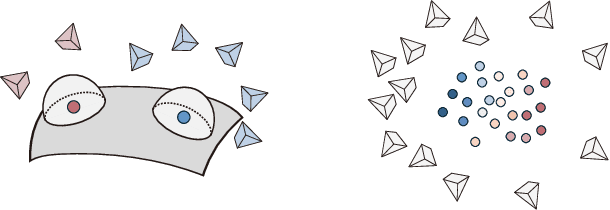


Abstract:We propose Camera Splatting, a novel view optimization framework for novel view synthesis. Each camera is modeled as a 3D Gaussian, referred to as a camera splat, and virtual cameras, termed point cameras, are placed at 3D points sampled near the surface to observe the distribution of camera splats. View optimization is achieved by continuously and differentiably refining the camera splats so that desirable target distributions are observed from the point cameras, in a manner similar to the original 3D Gaussian splatting. Compared to the Farthest View Sampling (FVS) approach, our optimized views demonstrate superior performance in capturing complex view-dependent phenomena, including intense metallic reflections and intricate textures such as text.
MT-Mol:Multi Agent System with Tool-based Reasoning for Molecular Optimization
May 27, 2025Abstract:Large language models (LLMs) have large potential for molecular optimization, as they can gather external chemistry tools and enable collaborative interactions to iteratively refine molecular candidates. However, this potential remains underexplored, particularly in the context of structured reasoning, interpretability, and comprehensive tool-grounded molecular optimization. To address this gap, we introduce MT-Mol, a multi-agent framework for molecular optimization that leverages tool-guided reasoning and role-specialized LLM agents. Our system incorporates comprehensive RDKit tools, categorized into five distinct domains: structural descriptors, electronic and topological features, fragment-based functional groups, molecular representations, and miscellaneous chemical properties. Each category is managed by an expert analyst agent, responsible for extracting task-relevant tools and enabling interpretable, chemically grounded feedback. MT-Mol produces molecules with tool-aligned and stepwise reasoning through the interaction between the analyst agents, a molecule-generating scientist, a reasoning-output verifier, and a reviewer agent. As a result, we show that our framework shows the state-of-the-art performance of the PMO-1K benchmark on 17 out of 23 tasks.
Slot-MLLM: Object-Centric Visual Tokenization for Multimodal LLM
May 26, 2025Abstract:Recently, multimodal large language models (MLLMs) have emerged as a key approach in achieving artificial general intelligence. In particular, vision-language MLLMs have been developed to generate not only text but also visual outputs from multimodal inputs. This advancement requires efficient image tokens that LLMs can process effectively both in input and output. However, existing image tokenization methods for MLLMs typically capture only global abstract concepts or uniformly segmented image patches, restricting MLLMs' capability to effectively understand or generate detailed visual content, particularly at the object level. To address this limitation, we propose an object-centric visual tokenizer based on Slot Attention specifically for MLLMs. In particular, based on the Q-Former encoder, diffusion decoder, and residual vector quantization, our proposed discretized slot tokens can encode local visual details while maintaining high-level semantics, and also align with textual data to be integrated seamlessly within a unified next-token prediction framework of LLMs. The resulting Slot-MLLM demonstrates significant performance improvements over baselines with previous visual tokenizers across various vision-language tasks that entail local detailed comprehension and generation. Notably, this work is the first demonstration of the feasibility of object-centric slot attention performed with MLLMs and in-the-wild natural images.
HyperCLOVA X Technical Report
Apr 13, 2024Abstract:We introduce HyperCLOVA X, a family of large language models (LLMs) tailored to the Korean language and culture, along with competitive capabilities in English, math, and coding. HyperCLOVA X was trained on a balanced mix of Korean, English, and code data, followed by instruction-tuning with high-quality human-annotated datasets while abiding by strict safety guidelines reflecting our commitment to responsible AI. The model is evaluated across various benchmarks, including comprehensive reasoning, knowledge, commonsense, factuality, coding, math, chatting, instruction-following, and harmlessness, in both Korean and English. HyperCLOVA X exhibits strong reasoning capabilities in Korean backed by a deep understanding of the language and cultural nuances. Further analysis of the inherent bilingual nature and its extension to multilingualism highlights the model's cross-lingual proficiency and strong generalization ability to untargeted languages, including machine translation between several language pairs and cross-lingual inference tasks. We believe that HyperCLOVA X can provide helpful guidance for regions or countries in developing their sovereign LLMs.
Discontinuity-preserving Normal Integration with Auxiliary Edges
Apr 04, 2024Abstract:Many surface reconstruction methods incorporate normal integration, which is a process to obtain a depth map from surface gradients. In this process, the input may represent a surface with discontinuities, e.g., due to self-occlusion. To reconstruct an accurate depth map from the input normal map, hidden surface gradients occurring from the jumps must be handled. To model these jumps correctly, we design a novel discretization scheme for the domain of normal integration. Our key idea is to introduce auxiliary edges, which bridge between piecewise-smooth patches in the domain so that the magnitude of hidden jumps can be explicitly expressed. Using the auxiliary edges, we design a novel algorithm to optimize the discontinuity and the depth map from the input normal map. Our method optimizes discontinuities by using a combination of iterative re-weighted least squares and iterative filtering of the jump magnitudes on auxiliary edges to provide strong sparsity regularization. Compared to previous discontinuity-preserving normal integration methods, which model the magnitudes of jumps only implicitly, our method reconstructs subtle discontinuities accurately thanks to our explicit representation of jumps allowing for strong sparsity regularization.
Hybrid Neural Representations for Spherical Data
Feb 05, 2024



Abstract:In this paper, we study hybrid neural representations for spherical data, a domain of increasing relevance in scientific research. In particular, our work focuses on weather and climate data as well as comic microwave background (CMB) data. Although previous studies have delved into coordinate-based neural representations for spherical signals, they often fail to capture the intricate details of highly nonlinear signals. To address this limitation, we introduce a novel approach named Hybrid Neural Representations for Spherical data (HNeR-S). Our main idea is to use spherical feature-grids to obtain positional features which are combined with a multilayer perception to predict the target signal. We consider feature-grids with equirectangular and hierarchical equal area isolatitude pixelization structures that align with weather data and CMB data, respectively. We extensively verify the effectiveness of our HNeR-S for regression, super-resolution, temporal interpolation, and compression tasks.
Mesh Density Adaptation for Template-based Shape Reconstruction
Jul 30, 2023Abstract:In 3D shape reconstruction based on template mesh deformation, a regularization, such as smoothness energy, is employed to guide the reconstruction into a desirable direction. In this paper, we highlight an often overlooked property in the regularization: the vertex density in the mesh. Without careful control on the density, the reconstruction may suffer from under-sampling of vertices near shape details. We propose a novel mesh density adaptation method to resolve the under-sampling problem. Our mesh density adaptation energy increases the density of vertices near complex structures via deformation to help reconstruction of shape details. We demonstrate the usability and performance of mesh density adaptation with two tasks, inverse rendering and non-rigid surface registration. Our method produces more accurate reconstruction results compared to the cases without mesh density adaptation.
Spatiotemporal Texture Reconstruction for Dynamic Objects Using a Single RGB-D Camera
Aug 20, 2021Abstract:This paper presents an effective method for generating a spatiotemporal (time-varying) texture map for a dynamic object using a single RGB-D camera. The input of our framework is a 3D template model and an RGB-D image sequence. Since there are invisible areas of the object at a frame in a single-camera setup, textures of such areas need to be borrowed from other frames. We formulate the problem as an MRF optimization and define cost functions to reconstruct a plausible spatiotemporal texture for a dynamic object. Experimental results demonstrate that our spatiotemporal textures can reproduce the active appearances of captured objects better than approaches using a single texture map.
Deep Virtual Markers for Articulated 3D Shapes
Aug 20, 2021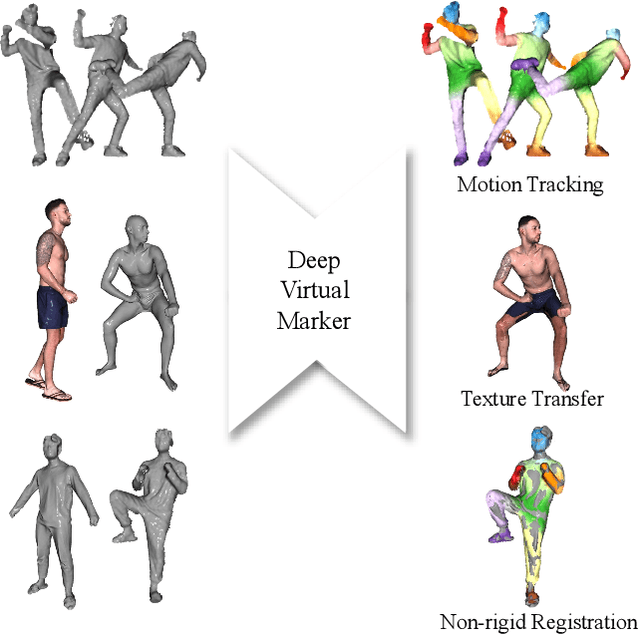
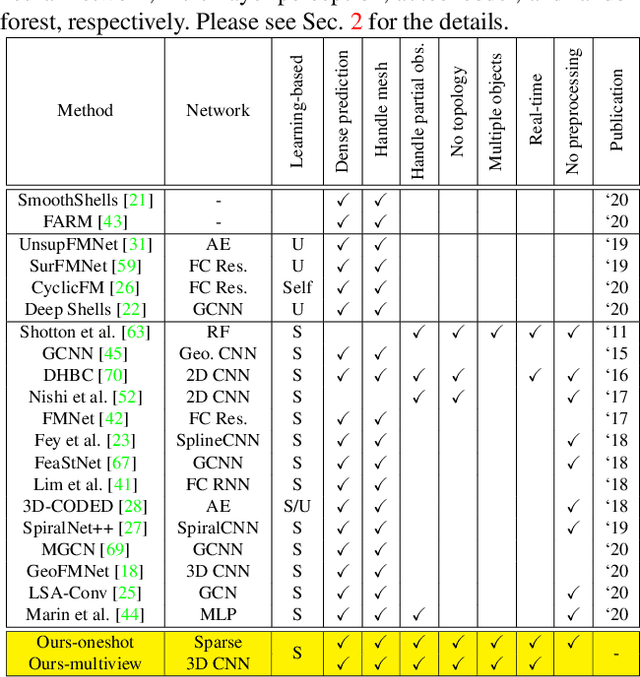
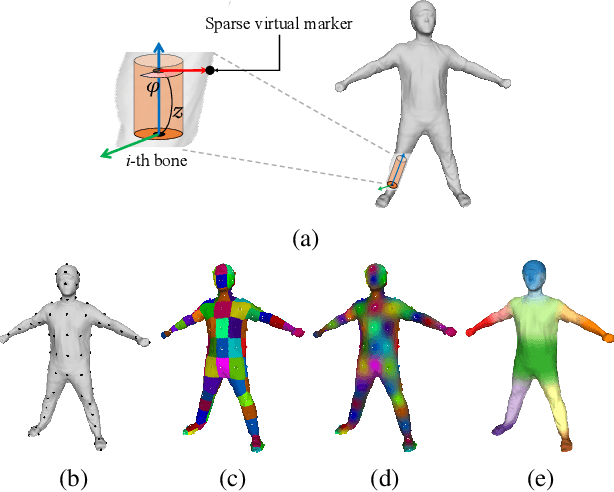
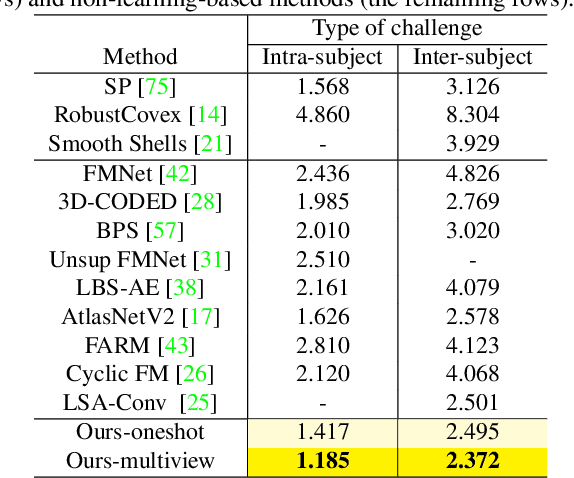
Abstract:We propose deep virtual markers, a framework for estimating dense and accurate positional information for various types of 3D data. We design a concept and construct a framework that maps 3D points of 3D articulated models, like humans, into virtual marker labels. To realize the framework, we adopt a sparse convolutional neural network and classify 3D points of an articulated model into virtual marker labels. We propose to use soft labels for the classifier to learn rich and dense interclass relationships based on geodesic distance. To measure the localization accuracy of the virtual markers, we test FAUST challenge, and our result outperforms the state-of-the-art. We also observe outstanding performance on the generalizability test, unseen data evaluation, and different 3D data types (meshes and depth maps). We show additional applications using the estimated virtual markers, such as non-rigid registration, texture transfer, and realtime dense marker prediction from depth maps.
Machine Learning in Heliophysics and Space Weather Forecasting: A White Paper of Findings and Recommendations
Jun 22, 2020Abstract:The authors of this white paper met on 16-17 January 2020 at the New Jersey Institute of Technology, Newark, NJ, for a 2-day workshop that brought together a group of heliophysicists, data providers, expert modelers, and computer/data scientists. Their objective was to discuss critical developments and prospects of the application of machine and/or deep learning techniques for data analysis, modeling and forecasting in Heliophysics, and to shape a strategy for further developments in the field. The workshop combined a set of plenary sessions featuring invited introductory talks interleaved with a set of open discussion sessions. The outcome of the discussion is encapsulated in this white paper that also features a top-level list of recommendations agreed by participants.
 Add to Chrome
Add to Chrome Add to Firefox
Add to Firefox Add to Edge
Add to Edge